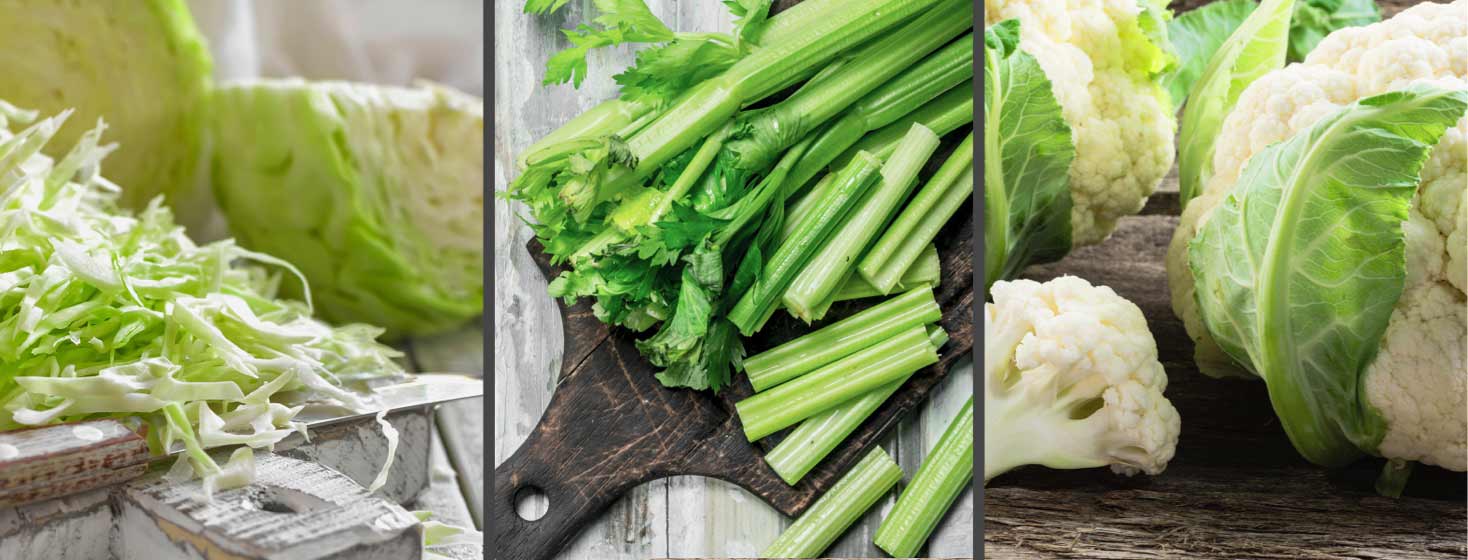Three C's: Cabbage, Cauliflower and Celery
Eating food in season is a great way to enjoy produce at its freshest, tastiest and at a more affordable price. Other noteworthy benefits of eating in season include, less use of pesticides and a greater nutritional value (especially anti-oxidants).
Low-carb vegetables for a type 2 diabetes diet
In January there are several fruits and vegetables that are in season. In this article I will focus on three different vegetables: Cabbage, Cauliflower and Celery (all of which are in season in January). These three vegetables not only start with the letter “C” but are also all low in the big “C” (AKA: Carbohydrates)
Keep reading to learn more about these three very versatile veggies!
Cabbage
Cabbage Nutrition Facts:
- Serving size: 1 cup, shredded
- Calories: 17 calories
- Carb: 4 g
- Sugar: 2 g
- Fiber: 2 g
- Protein: 1 g
- Fat: 0 g
- Sodium: 13 mg
Ideas for Enjoying:
- Coleslaw
- Cabbage soup
- Use purple cabbage to add color to salad
- Sauerkraut (fermented cabbage): enjoy on top of a hot dog, mix into scrambled eggs or add on top of a salad
- Sauerkraut is a natural source of probiotics. Probiotics are live microorganisms that help the growth of good bacteria in the gut. Probiotics may help reduce inflammation, oxidative stress, improve insulin sensitivity and reduced fasting glucose.
- Moo Shu Chicken Lettuce Cups
Recipe Idea:
Basic Coleslaw
Ingredients:
- 1 cup shredded cabbage
- 1 tablespoon mayonnaise
- ¼ teaspoon white vinegar
- ¾ teaspoon Dijon mustard
Directions:
- Combine mayonnaise, white vinegar and Dijon mustard with whisk in a small bowl
- Add in shredded cabbage
- Mix all ingredients together
Nutrition:
- Calories: 111
- Carb: 4 g
- Sugar: 0 g
- Fiber: 2 g
- Protein: 1 g
- Fat: 10 g
- Sodium: 173 mg
Celery
Celery Nutrition Facts:
- Serving size: 1 medium stalk
- Calories: 6 calories
- Carbs: 1 gram
- Sugar: < 1 gram
- Fiber: < 1 gram
- Protein: 0 g
- Fat: 0 g
- Sodium: 32 mg
Ideas of Enjoying:
- Mirepoix (A combination of chopped vegetables, commonly celery, onion, and carrots, cooked in a pan with meat or fish for added flavor.)
- Use as a vehicle for various toppings:
- Nut butters (peanut butter, almond butter, etc.)
- Tuna salad or egg salad
- Cream cheese and olives
- Cottage cheese and sliced cherry tomatoes
- Guacamole and sour cream
- Chopped Salad Jar
Recipe Idea:
Mediterranean Celery
Ingredients:
- 1 medium celery stalk
- 2 tablespoon hummus
- 1 tablespoons pine nuts
- 1 teaspoon olive oil
Directions:
- Trim ends of celery stalk
- Spread hummus evenly onto celery stalk
- Top with pine nuts
- Drizzle with olive oil
Nutrition:
- Calories: 160
- Carb: 7 g
- Sugar: 0 g
- Fiber: 3 g
- Protein: 4 g
- Fat: 14 g
- Sodium: 179 mg
Cauliflower
Cauliflower Nutrition Facts:
Serving size: 1 cup, chopped
Calories: 27
Carbs: 5
Sugar: 2
Fiber: 2
Protein: 2
Fat: 0
Sodium: 32 mg
Ideas of Enjoying:
- Cauliflower makes a wonderful mashed potato and rice alternative
- Toasted Cauliflower Rice
- Cauliflower Mac n Cheese
- Roasted with olive oil, salt and pepper
- Fresh with a ranch dip or hummus
Recipe Idea:
Parmesan crusted cauliflower
Ingredients: (yield 4 servings)
- 1 head cauliflower cut into large pieces
- 1/4 cup grated parmesan cheese
- 2 tablespoons olive oil
- Salt and pepper to taste
Directions:
- Preheat oven to 375 degrees
- Place pieces of cauliflower onto baking sheet
- Coat with olive oil, salt and pepper
- Mix all ingredients together with spatula or clean hands
- Sprinkle on grated parmesan cheese
- Bake at 375 degrees for approximately 25 minutes
Nutrition:
- Calories: 116
- Carb: 8 g
- Sugar: 0 g
- Fiber: 4 g
- Protein: 5 g
- Fat: 9 g
- Sodium: varies
Do you have a favorite winter vegetable recipe? Please share you ideas with the type2diabetes.com community.

Join the conversation